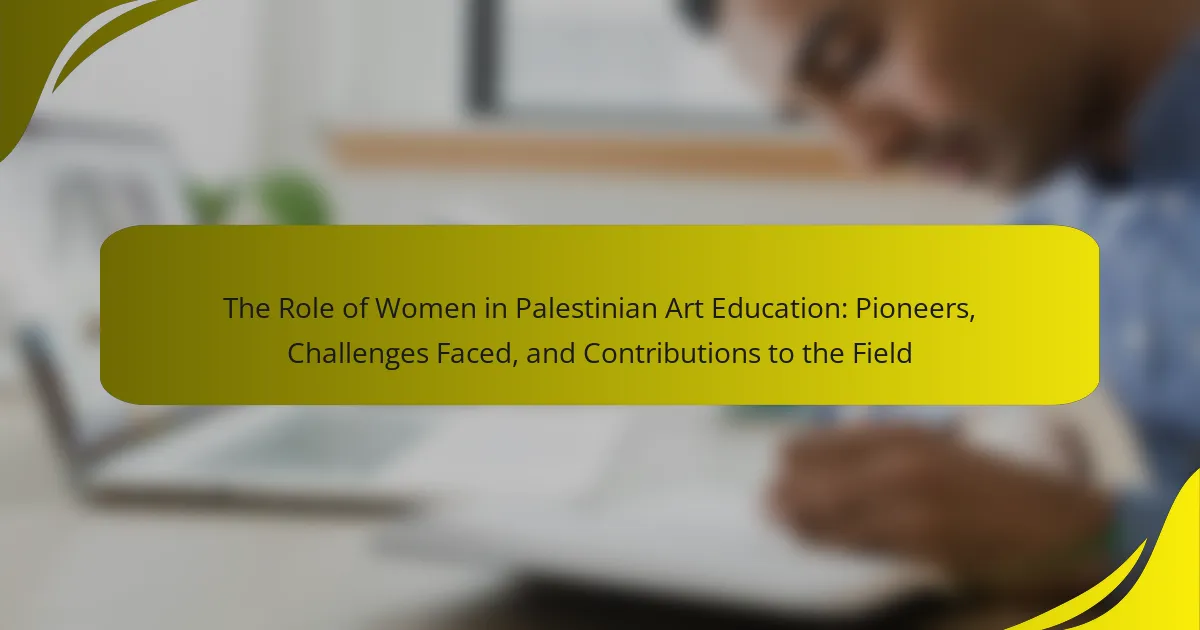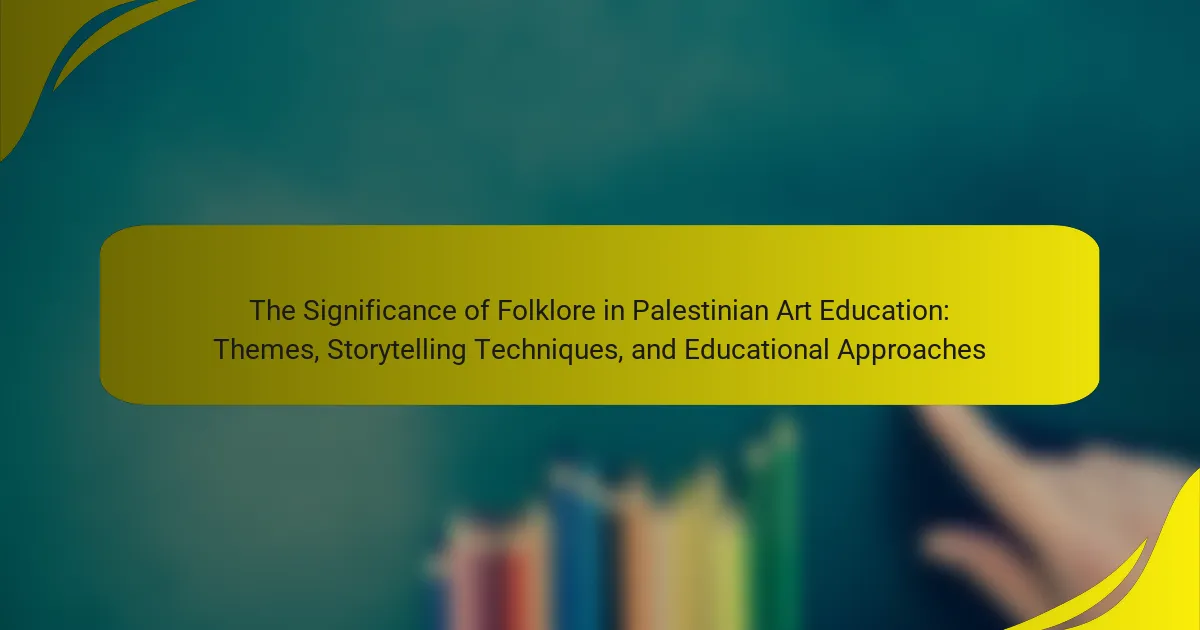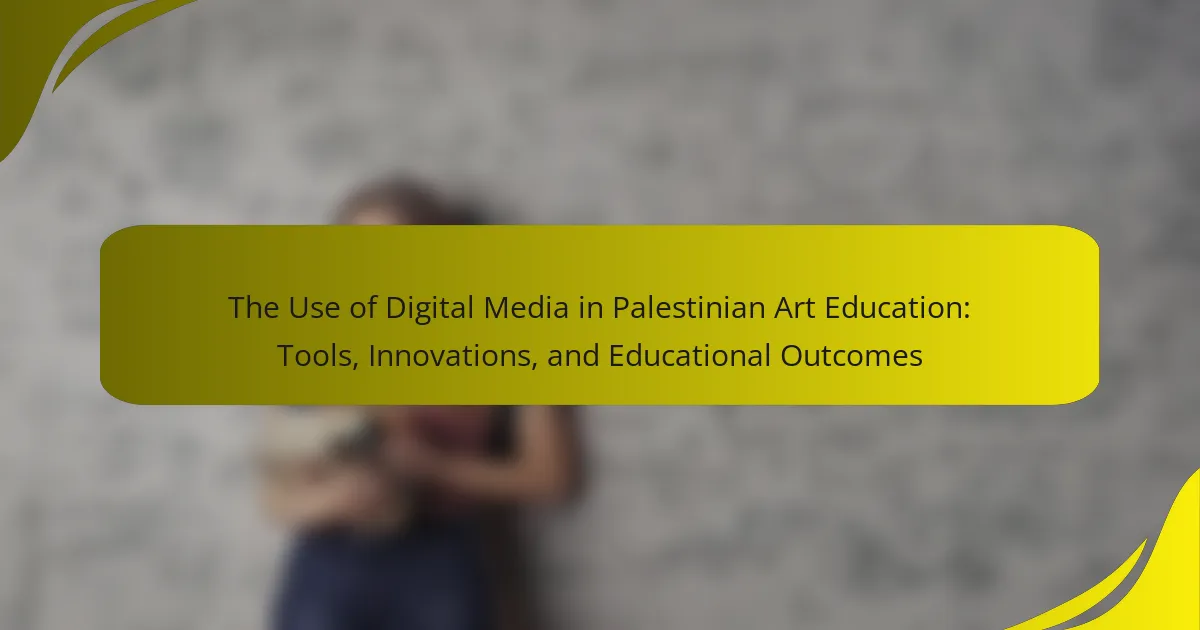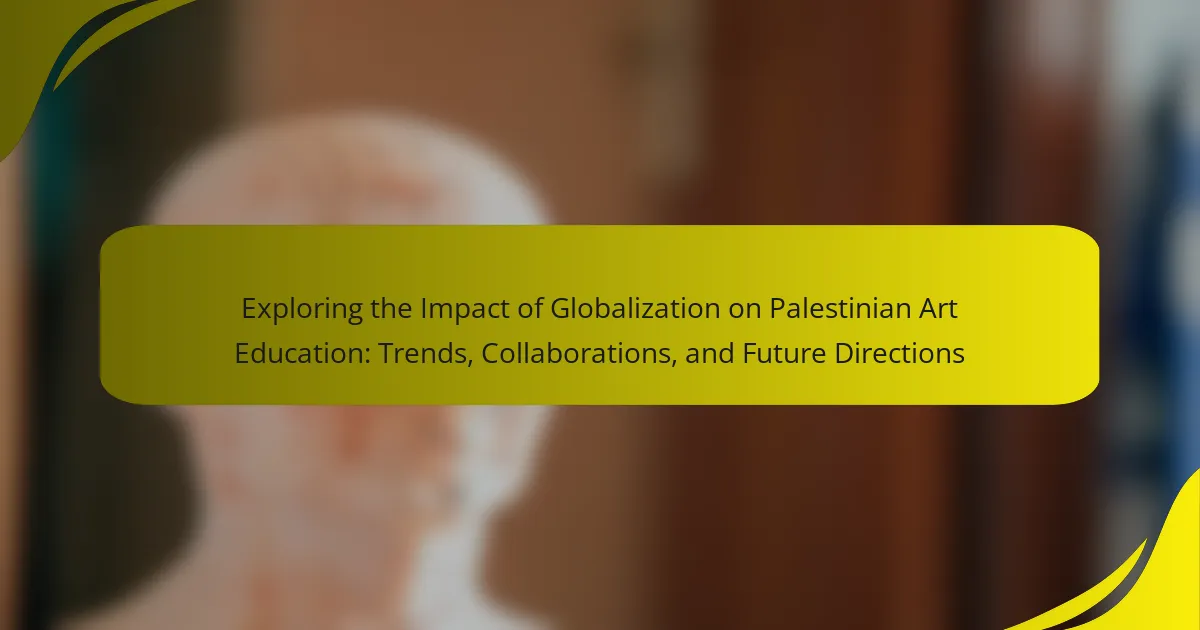Palestinian Art Education Institutions are dedicated establishments that focus on teaching and promoting various art disciplines, including visual arts, music, and performing arts within Palestine. These institutions, such as the International Academy of Art Palestine and the Palestinian Art Academy, aim to nurture local talent and preserve cultural heritage through a curriculum that blends traditional techniques with contemporary practices. They offer courses in painting, sculpture, graphic design, and art history, emphasizing hands-on experience and community engagement. By hosting exhibitions and outreach programs, these institutions play a crucial role in fostering a sense of pride in Palestinian cultural identity and ensuring the continuity of artistic traditions for future generations.
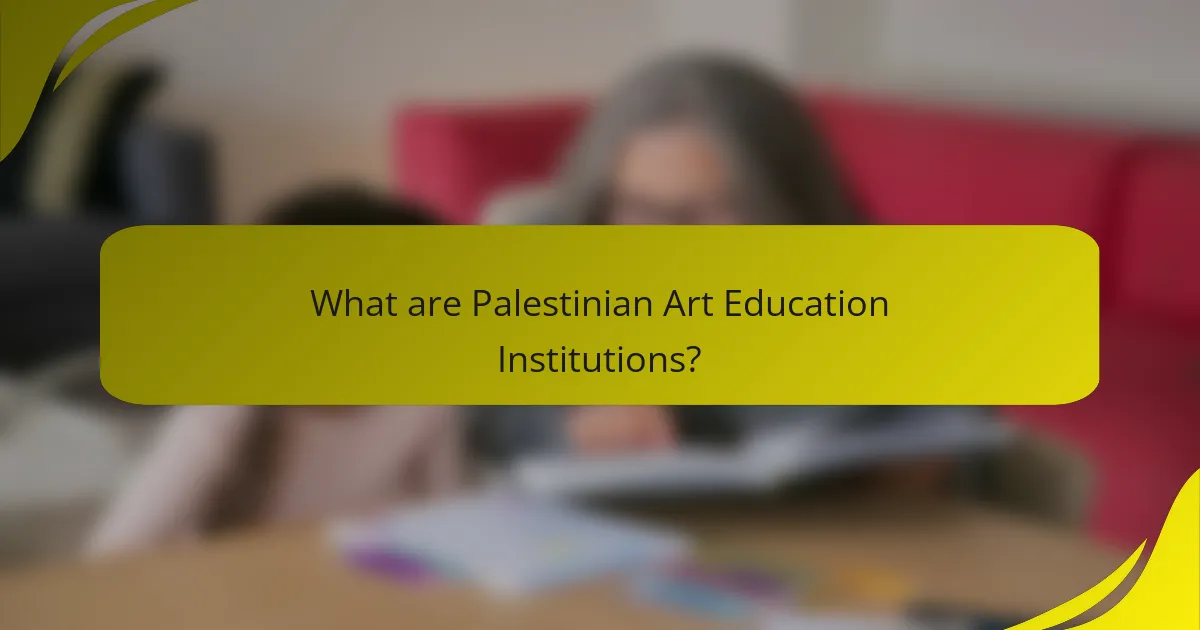
What are Palestinian Art Education Institutions?
Palestinian Art Education Institutions are establishments dedicated to teaching and promoting the arts in Palestine. They focus on various disciplines such as visual arts, music, and performing arts. These institutions aim to nurture local talent and preserve cultural heritage. Notable examples include the International Academy of Art Palestine and the Palestinian Art Academy. They offer programs that blend traditional techniques with contemporary practices. Many institutions also engage in community outreach and cultural events. These efforts contribute to the overall development of the Palestinian cultural landscape.
How did Palestinian Art Education Institutions develop over time?
Palestinian Art Education Institutions developed through historical and socio-political influences. Initially, these institutions emerged in the early 20th century. They were influenced by the broader Arab cultural renaissance. The establishment of institutions like the Bezalel Academy in Jerusalem played a pivotal role. In the 1970s, the rise of the Palestinian Liberation Organization led to increased emphasis on cultural identity. This period saw the founding of new art schools and programs. The Oslo Accords in the 1990s further shaped these institutions, allowing for international collaborations. Today, Palestinian art education continues to adapt, reflecting contemporary issues and cultural heritage.
What historical events influenced the establishment of these institutions?
The establishment of Palestinian art education institutions was influenced by several historical events. The 1948 Arab-Israeli War led to significant displacement and cultural loss, prompting a need for cultural preservation. The 1967 Six-Day War further intensified the urgency for educational frameworks that could support Palestinian identity. The rise of the Palestinian Liberation Organization in the late 1960s emphasized cultural expression as a form of resistance. The Oslo Accords in the 1990s allowed for greater autonomy, facilitating the development of educational institutions. These events collectively shaped a framework for establishing institutions dedicated to Palestinian art education.
What are the key milestones in the evolution of art education in Palestine?
The key milestones in the evolution of art education in Palestine include the establishment of the first art schools in the early 20th century. The Bezalel Academy of Arts and Design was founded in 1906 in Jerusalem, influencing local art education. In 1965, the Palestinian Liberation Organization initiated cultural programs, emphasizing art as a means of resistance. The 1994 establishment of the Palestinian Authority allowed for more structured art education initiatives. In 2000, the International Academy of Art Palestine was founded, promoting contemporary art practices. Additionally, various NGOs have supported art education programs since the early 2000s, expanding access and resources for students. These milestones reflect the ongoing development and resilience of art education in Palestine.
What role do Palestinian Art Education Institutions play in the community?
Palestinian Art Education Institutions play a crucial role in fostering cultural identity and community engagement. They provide essential training in various art forms, including visual arts, music, and theater. These institutions serve as platforms for artistic expression, allowing individuals to explore their heritage. They also promote social cohesion by bringing together diverse groups through collaborative projects. Furthermore, they contribute to the local economy by nurturing emerging artists and supporting creative industries. By hosting exhibitions and performances, these institutions enhance cultural visibility and appreciation within the community. Their impact is evidenced by increased participation in cultural events and a growing interest in the arts among youth.
How do these institutions foster cultural identity among students?
Palestinian art education institutions foster cultural identity among students by integrating local history and traditions into their curricula. They emphasize the importance of Palestinian heritage through various art forms. Students engage in projects that reflect their cultural narratives. Workshops and exhibitions showcase traditional techniques and contemporary interpretations. Collaborative art initiatives often involve community participation. This approach strengthens students’ connections to their cultural roots. Research indicates that such educational practices enhance students’ sense of belonging and identity. By valuing local artistic expressions, these institutions play a crucial role in cultural preservation.
What impact do they have on local and national cultural heritage?
Palestinian art education institutions significantly impact local and national cultural heritage. They foster artistic expression that reflects Palestinian identity and history. These institutions provide training that preserves traditional art forms. They also promote contemporary art that addresses social and political issues. By organizing exhibitions, they showcase local talent and engage the community. This visibility strengthens cultural pride and awareness. Additionally, they often collaborate with international artists, enhancing cultural exchange. Such interactions can lead to a broader understanding of Palestinian culture globally.
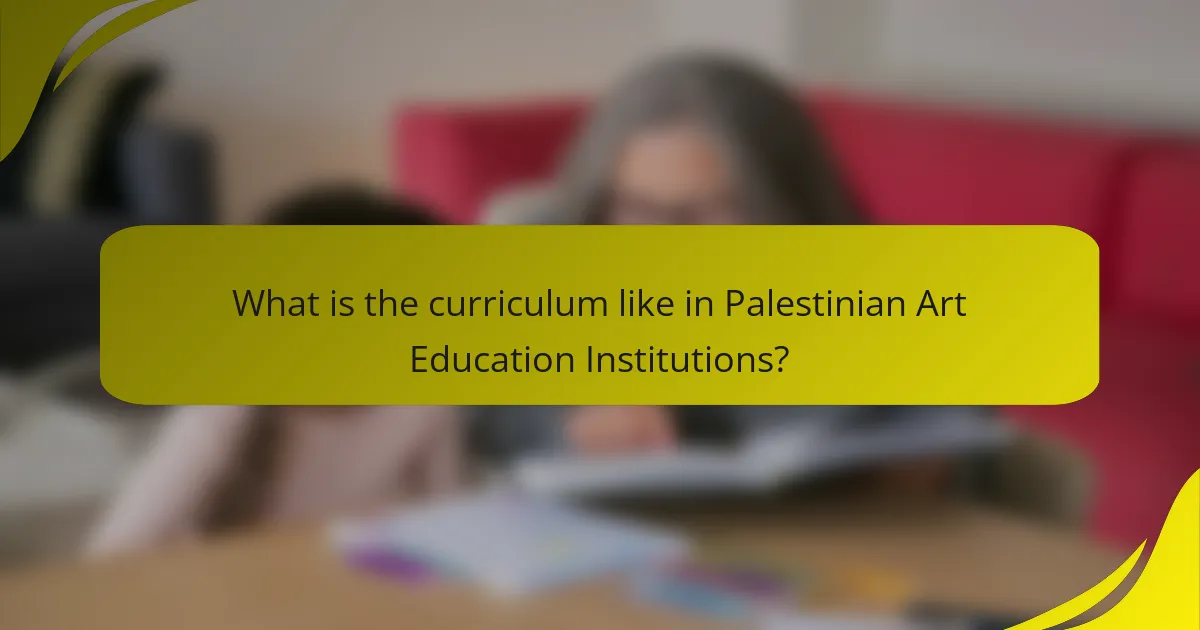
What is the curriculum like in Palestinian Art Education Institutions?
The curriculum in Palestinian Art Education Institutions emphasizes both traditional and contemporary art forms. It includes courses in painting, sculpture, and graphic design. Students also study art history and theory to understand cultural context. Practical workshops are integral, allowing hands-on experience in various mediums. Institutions often incorporate community projects to engage with local culture. The curriculum is designed to foster creativity and critical thinking. Collaboration with international artists is encouraged to broaden perspectives. This approach helps preserve and promote Palestinian cultural heritage through art.
What are the core subjects taught in these institutions?
Core subjects taught in Palestinian art education institutions include visual arts, design, and art history. Visual arts cover painting, sculpture, and printmaking. Design subjects focus on graphic design, interior design, and fashion design. Art history explores the evolution of art movements and cultural contexts. Additional subjects may include photography and digital media. These subjects aim to enhance students’ creativity and technical skills. Institutions emphasize the importance of cultural heritage in their curricula. This approach helps preserve and promote Palestinian identity through art.
How do art history and theory contribute to the curriculum?
Art history and theory are essential components of the curriculum in Palestinian art education institutions. They provide students with a foundational understanding of artistic movements and cultural contexts. This knowledge helps students appreciate the evolution of art within Palestinian heritage. Art history enables students to analyze works critically and understand their significance. Theory equips students with frameworks for interpreting art and its societal impact. Together, they foster critical thinking and creativity. This integration enriches the educational experience and prepares students for professional artistic practice.
What practical skills are emphasized in art programs?
Art programs emphasize practical skills such as drawing, painting, sculpture, and digital media. These skills are foundational to artistic expression and technical proficiency. Students learn to use various materials and techniques effectively. Programs often include hands-on workshops and studio practice. Collaboration and critique sessions help develop communication skills. Understanding art history and theory supports contextual knowledge. Portfolio development is crucial for showcasing work and skills. These practical skills prepare students for careers in the arts and related fields.
How is the curriculum adapted to local cultural contexts?
The curriculum in Palestinian art education institutions is adapted to local cultural contexts by integrating traditional Palestinian themes and practices. This adaptation reflects the unique history and identity of the Palestinian people. Courses often include studies of local art forms, such as embroidery and calligraphy. Additionally, the curriculum emphasizes the importance of cultural heritage and its representation in contemporary art. Local artists and cultural figures are frequently invited to share their insights and experiences. This approach fosters a connection between students and their cultural roots. Research indicates that culturally relevant curricula enhance student engagement and identity formation.
What unique artistic practices are incorporated into the curriculum?
The curriculum incorporates unique artistic practices such as traditional Palestinian embroidery and calligraphy. These practices reflect cultural heritage and identity. Students engage in workshops that emphasize these techniques. Additionally, the curriculum includes contemporary art forms like installation and performance art. These modern practices encourage critical thinking and innovation. The integration of both traditional and contemporary methods enriches the educational experience. This approach fosters a deeper understanding of Palestinian culture and its artistic expressions.
How do institutions address contemporary issues through art education?
Institutions address contemporary issues through art education by integrating relevant themes into their curriculum. This includes topics such as identity, social justice, and environmental concerns. Art education programs encourage critical thinking and dialogue among students. They often involve community engagement projects that respond to local challenges. Workshops and exhibitions showcase student work that reflects contemporary societal issues. Collaboration with local artists further enriches the learning experience. Research shows that art can foster empathy and awareness, making it a powerful tool for social change. Institutions utilize these methods to prepare students for active citizenship in a complex world.
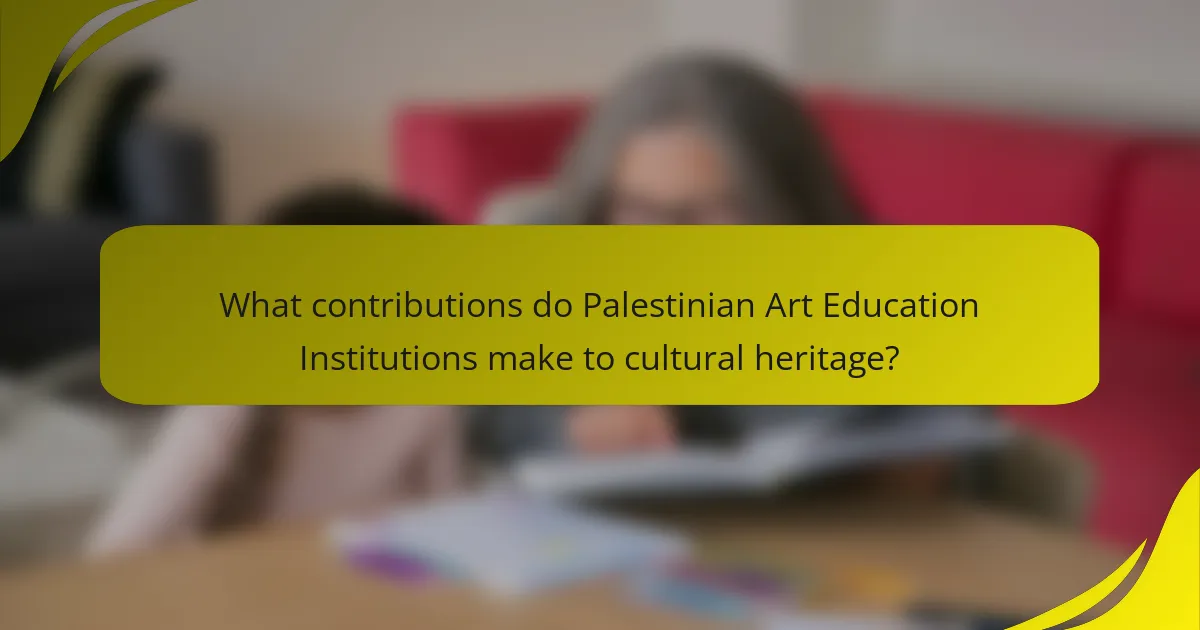
What contributions do Palestinian Art Education Institutions make to cultural heritage?
Palestinian Art Education Institutions contribute significantly to cultural heritage by preserving and promoting local artistic traditions. They provide a platform for artists to express their identity and experiences. These institutions often integrate traditional art forms into their curricula. This includes calligraphy, pottery, and textile arts, which are vital to Palestinian culture.
Furthermore, they host exhibitions that showcase contemporary interpretations of these traditions. They also engage in community outreach programs that educate the public about Palestinian art history. These efforts help to foster a sense of pride and continuity within the community. By nurturing emerging artists, these institutions ensure the survival of cultural practices for future generations.
How do these institutions preserve traditional art forms?
Palestinian art education institutions preserve traditional art forms through various methods. They offer specialized programs focused on traditional techniques and materials. Students learn from experienced artisans and artists who pass down knowledge. Workshops often include hands-on training in crafts like embroidery and pottery. Institutions also host exhibitions showcasing traditional art to the public. They collaborate with local communities to ensure cultural relevance. Research indicates that these educational programs foster a sense of identity and heritage among students. By integrating traditional art into the curriculum, these institutions play a vital role in cultural preservation.
What role do they play in documenting Palestinian art history?
Palestinian art education institutions play a crucial role in documenting Palestinian art history. They preserve artistic expressions that reflect the cultural identity of Palestinians. These institutions collect, archive, and exhibit artworks that capture historical narratives. They provide platforms for artists to showcase their work, ensuring visibility for diverse artistic voices. Through research and scholarship, they contribute to the academic study of Palestinian art. Programs often include oral histories that document artists’ experiences and perspectives. Their efforts enhance the understanding of art as a form of resistance and resilience. By fostering creativity, they help to maintain a continuous dialogue about Palestinian culture and heritage.
How do they support emerging artists and their work?
Palestinian art education institutions support emerging artists through mentorship programs and workshops. They provide resources such as studio space and access to materials. Institutions often host exhibitions to showcase student work. They facilitate networking opportunities with established artists. Additionally, they offer scholarships to talented individuals. These initiatives help cultivate artistic skills and promote cultural expression. Research indicates that such support enhances the visibility of emerging artists in the community.
In what ways do Palestinian Art Education Institutions collaborate with the community?
Palestinian Art Education Institutions collaborate with the community through various programs and initiatives. They often engage in community art projects that involve local residents. These projects aim to foster creativity and cultural expression. Institutions also host workshops and exhibitions showcasing local talent. Collaborations with local artists enhance educational experiences for students. Additionally, partnerships with community organizations promote outreach and accessibility. This engagement helps preserve and celebrate Palestinian cultural heritage. These collaborative efforts strengthen community ties and encourage artistic dialogue.
What partnerships exist between these institutions and local artists?
Partnerships between Palestinian art education institutions and local artists often include collaborative projects and exhibitions. These institutions frequently invite local artists to participate in workshops and lectures. This engagement fosters a vibrant artistic community and enhances the curriculum. For instance, institutions may host joint exhibitions showcasing student and artist works. Additionally, local artists often serve as mentors to students, providing practical insights. Some institutions also partner with artists for community outreach programs. These partnerships aim to promote cultural heritage and support local talent.
How do community outreach programs enhance cultural engagement?
Community outreach programs enhance cultural engagement by fostering connections between diverse groups. They provide platforms for sharing cultural practices and artistic expressions. These programs often include workshops, exhibitions, and collaborative projects. Such activities promote understanding and appreciation of different cultural backgrounds. Research shows that community involvement in arts leads to increased participation in cultural events. A study by the National Endowment for the Arts found that communities with outreach programs see higher attendance at cultural activities. This engagement strengthens community ties and encourages cultural dialogue. Overall, outreach initiatives are vital for enriching cultural experiences and promoting inclusivity.
What are some best practices for supporting Palestinian Art Education Institutions?
Supporting Palestinian Art Education Institutions involves several best practices. First, provide financial assistance to sustain operations and programs. This funding can support scholarships, materials, and facilities. Second, establish partnerships with international art organizations. Collaborations can enhance resources and broaden exposure for students. Third, promote cultural exchange programs. These initiatives can foster understanding and appreciation of Palestinian art on a global scale. Fourth, advocate for the inclusion of Palestinian art in educational curricula worldwide. This promotes visibility and recognition of its significance. Fifth, create platforms for showcasing student work. Exhibitions can highlight talent and attract potential supporters. Lastly, invest in teacher training and professional development. Skilled educators enhance the quality of art education. These practices collectively strengthen the impact of Palestinian Art Education Institutions.
Palestinian Art Education Institutions are establishments focused on teaching and promoting various art forms in Palestine, including visual arts, music, and performing arts. This article provides an overview of their development, key milestones, and the role they play in fostering cultural identity and community engagement. It highlights the curriculum, which integrates traditional and contemporary practices, and discusses the institutions’ contributions to preserving cultural heritage. Additionally, the article examines how these institutions support emerging artists and collaborate with the community to enhance cultural engagement and visibility.
